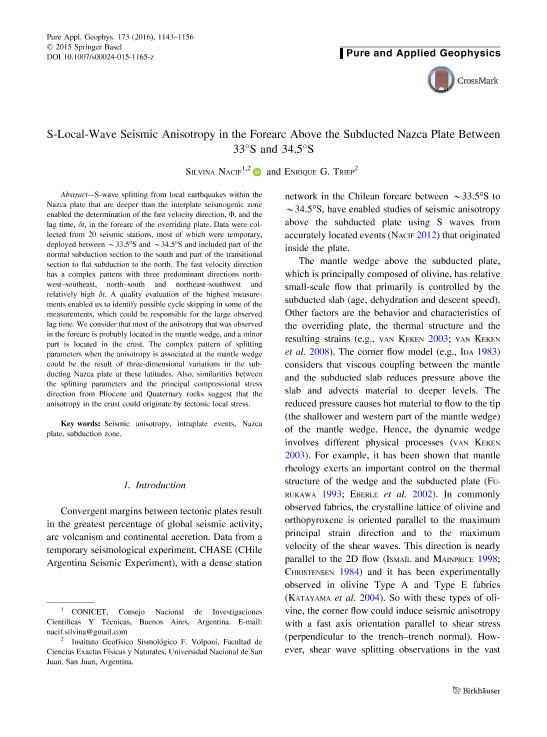Mostrar el registro sencillo del ítem
dc.contributor.author
Nacif Suvire, Silvina Valeria

dc.contributor.author
Triep, Enrique Gaudencio

dc.date.available
2018-05-23T18:37:08Z
dc.date.issued
2016-04
dc.identifier.citation
Nacif Suvire, Silvina Valeria; Triep, Enrique Gaudencio; S-Local-Wave Seismic Anisotropy in the Forearc Above the Subducted Nazca Plate Between 33°S and 34.5°S; Birkhauser Verlag Ag; Pure And Applied Geophysics; 173; 4; 4-2016; 1143-1156
dc.identifier.issn
0033-4553
dc.identifier.uri
http://hdl.handle.net/11336/46007
dc.description.abstract
S-wave splitting from local earthquakes within the Nazca plate that are deeper than the interplate seismogenic zone enabled the determination of the fast velocity direction, U, and the lag time, dt, in the forearc of the overriding plate. Data were collected from 20 seismic stations, most of which were temporary,deployed between *33.5S and *34.5S and included part of the normal subduction section to the south and part of the transitional section to flat subduction to the north. The fast velocity direction has a complex pattern with three predominant directions northwest?southeast, north?south and northeast?southwest and relatively high dt. A quality evaluation of the highest measurements enabled us to identify possible cycle skipping in some of themeasurements, which could be responsible for the large observed lag time. We consider that most of the anisotropy that was observed in the forearc is probably located in the mantle wedge, and a minor part is located in the crust. The complex pattern of splitting parameters when the anisotropy is associated at the mantle wedge could be the result of three-dimensional variations in the subducting Nazca plate at these latitudes. Also, similarities between the splitting parameters and the principal compressional stress direction from Pliocene and Quaternary rocks suggest that the anisotropy in the crust could originate by tectonic local stress.
dc.format
application/pdf
dc.language.iso
eng
dc.publisher
Birkhauser Verlag Ag

dc.rights
info:eu-repo/semantics/openAccess
dc.rights.uri
https://creativecommons.org/licenses/by-nc-sa/2.5/ar/
dc.subject
Seismic Anisotropy
dc.subject
Intraplate Events
dc.subject
Nazca Plate
dc.subject
Subduction Zone
dc.subject.classification
Otras Ciencias de la Tierra y relacionadas con el Medio Ambiente

dc.subject.classification
Ciencias de la Tierra y relacionadas con el Medio Ambiente

dc.subject.classification
CIENCIAS NATURALES Y EXACTAS

dc.title
S-Local-Wave Seismic Anisotropy in the Forearc Above the Subducted Nazca Plate Between 33°S and 34.5°S
dc.type
info:eu-repo/semantics/article
dc.type
info:ar-repo/semantics/artículo
dc.type
info:eu-repo/semantics/publishedVersion
dc.date.updated
2018-05-03T13:58:20Z
dc.journal.volume
173
dc.journal.number
4
dc.journal.pagination
1143-1156
dc.journal.pais
Suiza

dc.journal.ciudad
Basel
dc.description.fil
Fil: Nacif Suvire, Silvina Valeria. Consejo Nacional de Investigaciones Científicas y Técnicas; Argentina. Universidad Nacional de San Juan. Facultad de Ciencias Exactas, Físicas y Naturales. Instituto Geofísico Sismológico Volponi; Argentina
dc.description.fil
Fil: Triep, Enrique Gaudencio. Universidad Nacional de San Juan. Facultad de Ciencias Exactas, Físicas y Naturales. Instituto Geofísico Sismológico Volponi; Argentina
dc.journal.title
Pure And Applied Geophysics

dc.relation.alternativeid
info:eu-repo/semantics/altIdentifier/doi/https://dx.doi.org/10.1007/s00024-015-1165-z
dc.relation.alternativeid
info:eu-repo/semantics/altIdentifier/url/https://link.springer.com/article/10.1007%2Fs00024-015-1165-z
Archivos asociados
